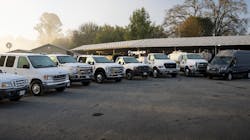Ford CFO: Commercial Fleets Will Be Model for Higher Life Cycle Revenues
Ford Motor Co.’s CFO said April 13 that the growth of electric vehicles and the larger amount of software and electronics in them are changing the economics of the automotive life cycle and that Ford’s commercial division will show the company’s consumer business how to best capitalize on that.
Speaking to the Bank of America Securities 2022 Global Automotive Summit, John Lawler said the increasingly technology-connected vehicles of today and of the future will help Ford and other auto makers extend the length of customer relationships and retain more maintenance revenues. The company last spring packaged its commercial manufacturing and services – think telematics, fleet management, charging management and other offerings – business under the Ford Pro brand and said it expects sales from that group to grow to $45 billion in 2025 from $27 billion in 2019. Lawler said much of that growth won’t come from traditional sources.
“If somebody would have said to me five years ago, ‘How is the last 10 years of your career going to work out?’ Well, it’s going to be capital-intensive, margins are going to be difficult, those who have the freshest lineup are going to have an advantage for a period of time and we’re going to continue to battle it out,” Lawler told conference attendees. “That’s completely changed now with these connected platforms, services and experiences […] Ford Pro is going to be the area where we see that first.”
Lawler added that Ford expects to grow revenues in part by doing far more post-warranty service work on customers’ vehicles – “I think people underestimate just how big that is” – and over time use its stickier network to grow its share of customers’ fleets. That virtuous cycle could also be applied to consumer cars to help buyers manage their maintenance and decide when to move onto a new vehicle.
Lawler’s remarks at BofA’s gathering also addressed Ford’s announcement from early March that it will formally separate its EV and internal combustion engine operations even though they'll continue to work together in many ways. The move, he said, is helping each division focus on its priorities as part of Ford’s plan to grow its adjusted profit margin to 10% by 2026 from 7.3% last year – even as the EV group is set for $5 billion of investment this year while the ICE division is focused on cost controls and quality improvements.
“Are there going to be some pockets of tension, etcetera? Yeah, but we need to work through that,” Lawler said. “That’s only natural. It’s a big change for the company.”
Ford shares (Ticker: F) were up 1% to about $15.50 on the afternoon of April 13. Over the past six months, they are essentially flat.
About the Author
Geert De Lombaerde
Senior Editor
A native of Belgium, Geert De Lombaerde has been in business journalism since the mid-1990s and writes about public companies, markets and economic trends for Endeavor Business Media publications, focusing on IndustryWeek, FleetOwner, Oil & Gas Journal, T&D World and Healthcare Innovation. He also curates the twice-monthly Market Moves Strategy newsletter that showcases Endeavor stories on strategy, leadership and investment and contributes to other Market Moves newsletters.
With a degree in journalism from the University of Missouri, he began his reporting career at the Business Courier in Cincinnati in 1997, initially covering retail and the courts before shifting to banking, insurance and investing. He later was managing editor and editor of the Nashville Business Journal before being named editor of the Nashville Post in early 2008. He led a team that helped grow the Post's online traffic more than fivefold before joining Endeavor in September 2021.
